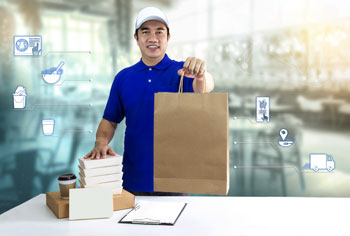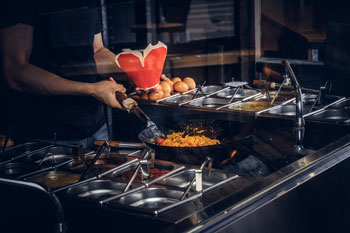Are third-party food delivery companies a nuisance or business opportunity?
Sixty percent of restaurants fail within their first five years. But that’s not stopping restaurateurs from starting or expanding their businesses. According to The Balance Small Business, 2016 was the first time in US history that Americans spent more on prepared food than on groceries, which is great news for restaurant owners. Data shows that consumers increased their spending on online food delivery in 2019 by almost 15 percent from last year. In fact, revenue in restaurant-to-customer delivery is projected to grow at a rate of about six percent per year by 2023, according statista.com.
In Atlanta alone, spending through food delivery service platforms (like Grubhub) is increasing by 200 percent year-over-year, and about 65 percent of that spending is from millennials, who prefer to use UberEATS over other platforms available in the city, according to research.
How does third-party food delivery work?

Restaurant patrons can view menus, place orders, pay for meals and have them delivered using a web or mobile application. There is generally an additional delivery fee that is charged by the third party, Grubhub, UberEATS, Doordash and so on. Once an order is placed, the restaurant is notified through the establishment’s POS system and when the food is ready, drivers that work for the various food delivery companies pick up the meals and deliver to patrons. Once a transaction is complete, the payment is dispersed to all parties involved.
According to the National Restaurant Association’s research group, 63 percent of restaurant traffic is now off premises nationwide. This is creating a shift in perception of what a restaurant is.
However, some restaurant owners are seeing the drawbacks of participating in third-party delivery services. Others can’t afford to ignore third-party apps, as they bring in much needed extra business; but they do admit that it brings its challenges. There are completely different issues to consider such as additional storage for take-out containers and bags, figuring out who will manage the online orders, or if menu items will travel long-distances well.
One restaurant owner stopped participating in third-party delivery programs altogether because it became a more of a problem than a bonus. Kitchens were being flooded with third party orders, which count for a 70% ticket with the 30% third-party fee. Dine-in or 100% tickets were getting more difficult to manage, and that wasn’t making sense for the business. Other owners compare it to running another business on top of their existing business.
Pros and cons of using third-party delivery services
| Pros | Cons |
| Add a new revenue stream | Large order volumes at peak hours can overstress the kitchen |
| Increase sales without having to add seats in your brick-and-mortar | Services can take up to 30 percent profit for each sale |
| Adds an additional marketing platform | May require additional labor to manage third-party orders |
| Access to a larger customer base who already order takeout | Each third party has its own platform that you may need to integrate with your POS |
| Opportunity to start a virtual or ghost restaurant concept to grow your business | Hard to control the quality of food being delivered, affecting reputation |

Owners and operators must learn how to adapt to consumer food-delivery preferences and organize in-house operations to be as efficient as possible so that there is additional profit gained, and not lost, from this model.
Some owners are adapting to this shift by opening ghost restaurants. Two Georgia restauranteurs, owners of Under The CorkTree restaurants, Jason Sheetz and William Sigley, decided to discontinue third-party services at their brick-and-mortar locations and open a virtual (ghost restaurant) concept in Sandy Springs. The virtual restaurant is set up at a kitchen facility near one of their brick-and-mortar restaurants and will house three different menu concepts, each with their own name, which will rely on third-party delivery. The owners anticipate a revenue increase with this model since overhead costs have been eliminated.
What is a ghost restaurant?
A virtual restaurant, often referred to as a “ghost restaurant,” is a foodservice operation that offers delivery-only meals, usually at the fine dining level, through digital applications and/or third-party services. This delivery-only model decreases overhead costs, as the traditional expenses that come with a brick-and-mortar location such as wait staff, in-house dining service and everything that comes with it are eliminated.
Uber Eats started testing the virtual restaurant model in 2017 with poke bowls, as they saw many customers searching for them within the Uber Eats app but not able to find it. Now it is one of the most popular delivery food items across the nation.
The virtual or ghost restaurant business model is becoming increasingly popular as technology improves the user experience. For example, Grubhub, who owns another online delivery service called Seamless, recently purchased a company called LevelUp, which helps restaurants develop digital payment services and loyalty programs. So, restaurants who partner with GrubHub can take advantage of third-party services and get even greater ROI with repeat customers.
Benefits of owning a virtual restaurant
- Lowered overhead costs because there’s no need for waitstaff or dining space
- Lower rent due to decreased need for space
- Provides more menu flexibility and better concept testing opportunities
- Reduces financial risk for startups
What customers want
The ghost restaurant concept is not new and has been tried and failed many times in the last few years. Customers in the takeout/online order market will not eat just anything. Kitchen United, a commissary kitchen and virtual restaurant service provider, reports that not only do customers want fried chicken, they want delicious fried chicken. Like with all restaurant concepts, it starts and ends with food quality.
Customers want good food from places they know and like. If it is a new concept or restaurant, not only does the food quality need to be consistent, fresh and fast, it needs to be priced right. Kitchen United helps virtual restaurants develop a delivery model with the service provider of their choice to create seamless experiences for their customers. Services include access to commercial kitchen spaces complete with equipment and BOH staff.
Using data to meet customers where they are
The technological impact from restaurants using third-party services like UberEATS is creating more opportunities to improve the user experience in the takeout market.
For instance, UberEATS contacted a local pizzeria in a Chicago neighborhood when they found that people in the area were searching for “chicken” through their delivery app and not finding available options. They propositioned the pizzeria to start a virtual restaurant that only serves fried chicken.
Rather than just adding fried chicken to their pizza menu, the pizzeria worked with UberEATS to market the concept. They built a virtual menu that offers fried chicken, chicken tenders and chicken pizza, and it’s all made in the pizzeria’s kitchen using equipment they already had. Virtual sales ended up exceeding pizza delivery sales over time, according to Restaurant-hospitality.com
Things to consider when starting a virtual restaurant

Location. While virtual restaurants do well in heavily populated areas, it may prove smart to look for space closer to residential neighborhoods.
Expenses. Consider expense factors like rent, ingredients, storage, cook staff and the cost of using third-party online ordering and delivery partners when starting and make sure you price menu items accordingly so you can maximize your profit margin.
Product. What are you going to serve? Is it serving a need in the area (as in filling a lack of that cuisine type)? Is it unique enough that it will stand out on a delivery app and will it travel well?
Marketing.With overhead expenses being diminished, you may have more resources to put into your business that will increase sales, like marketing. Tactics like favorable reviews, social media marketing and an optimized website are ways to drive online orders and work just as well as with a traditional restaurant. Keeping your menu up to date is probably the most important thing you can do.
While third-party delivery can cause added stress to some restaurant owners, it is a trend that isn’t going anywhere and can prove to create additional streams of income for your business when done with efficiency. Luckily, now, thanks to the virtual restaurant trend, it is easier than ever for restaurant owners to branch out and increase their revenue streams while not creating a burden on their kitchen, and it gives restaurateurs the chance to start new restaurant businesses for nominal startup costs. It will be interesting to see how technology continues to play a major role in keeping these trends profitable for all parties involved.
Did you enjoy this article? Click here to stay up-to-date on industry news and receive exclusive sales and promotions.


